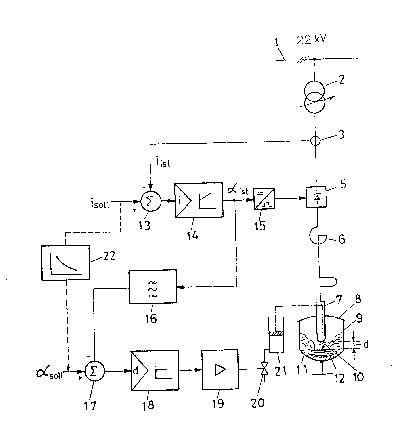Some of the information on this Web page has been provided by external sources. The Government of Canada is not responsible for the accuracy, reliability or currency of the information supplied by external sources. Users wishing to rely upon this information should consult directly with the source of the information. Content provided by external sources is not subject to official languages, privacy and accessibility requirements.
Any discrepancies in the text and image of the Claims and Abstract are due to differing posting times. Text of the Claims and Abstract are posted:
| (12) Patent Application: | (11) CA 2060006 |
|---|---|
| (54) English Title: | PROCESS FOR ELECTRODE CONTROL OF A DC ARC FURNACE, AND AN ELECTRODE CONTROL DEVICE |
| (54) French Title: | PROCEDE ET DISPOSITIF DE COMMANDE DES ELECTRODES POUR FOUR A ARC A COURANT CONTINU |
| Status: | Deemed Abandoned and Beyond the Period of Reinstatement - Pending Response to Notice of Disregarded Communication |
| (51) International Patent Classification (IPC): |
|
|---|---|
| (72) Inventors : |
|
| (73) Owners : |
|
| (71) Applicants : |
|
| (74) Agent: | SWABEY OGILVY RENAULT |
| (74) Associate agent: | |
| (45) Issued: | |
| (22) Filed Date: | 1992-01-24 |
| (41) Open to Public Inspection: | 1992-08-09 |
| Availability of licence: | N/A |
| Dedicated to the Public: | N/A |
| (25) Language of filing: | English |
| Patent Cooperation Treaty (PCT): | No |
|---|
| (30) Application Priority Data: | ||||||
|---|---|---|---|---|---|---|
|
ABSTRACT OF THE DISCLOSURE
DC arc furnaces (8) have a current controller
(14) for stabilizing the current of an arc (10), and an
electrode controller (18) for influencing the position
of an electrode (7) of the arc furnace (8) and thus the
length of an arc (10). The control of the position of
the electrode (7) is performed by means of a hydraulic
electrode adjusting device (21), which is controlled as
a function of a difference between a prescribable
electrode controller reference variable signal (.alpha.des)
and a rectifier manipulated variable signal (.alpha.act) at
the output of the current controller (14). As a result,
the arc length is regulated such that a rectifier (5)
operates on average with a drive level of, for example,
25° electrical, irrespective of the secondary voltage
of a furnace transformer (2) and of an adjusted desired
current value signal (ides). Limiting values are
monitored and undesired frequencies are filtered out by
means of a bandpass filter (16) between the output of
the current controller (14) and a comparator or summer
(17) for forming the difference signal between the
electrode controller reference variable signal (.alpha.des)
and the rectifier manipulative variable signal (.alpha.act).
Note: Claims are shown in the official language in which they were submitted.
Note: Descriptions are shown in the official language in which they were submitted.

2024-08-01:As part of the Next Generation Patents (NGP) transition, the Canadian Patents Database (CPD) now contains a more detailed Event History, which replicates the Event Log of our new back-office solution.
Please note that "Inactive:" events refers to events no longer in use in our new back-office solution.
For a clearer understanding of the status of the application/patent presented on this page, the site Disclaimer , as well as the definitions for Patent , Event History , Maintenance Fee and Payment History should be consulted.
| Description | Date |
|---|---|
| Inactive: IPC from MCD | 2006-03-11 |
| Inactive: IPC from MCD | 2006-03-11 |
| Time Limit for Reversal Expired | 1996-07-24 |
| Application Not Reinstated by Deadline | 1996-07-24 |
| Deemed Abandoned - Failure to Respond to Maintenance Fee Notice | 1996-01-24 |
| Inactive: Adhoc Request Documented | 1996-01-24 |
| Application Published (Open to Public Inspection) | 1992-08-09 |
| Abandonment Date | Reason | Reinstatement Date |
|---|---|---|
| 1996-01-24 |
Note: Records showing the ownership history in alphabetical order.
| Current Owners on Record |
|---|
| ASEA BROWN BOVERI LTD. |
| Past Owners on Record |
|---|
| EDUARD STREBEL |